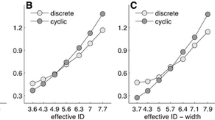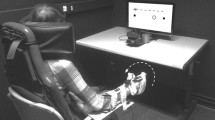Abstract
An experiment was designed to determine the degree to which instruction and visual display influence participants’ performance and control characteristics when executing difficult reciprocal aiming movements. Participants were randomly assigned to one of the three acquisition conditions (Fitts, Impulse and Sine). Participants in the Fitts condition were asked to flex/extend their limb/lever in the horizontal plane at the elbow joint (wrist stabilized) in an attempt to move back and forth between two targets as quickly and accurately as possible. In the Impulse condition, participants moved between two target lines paced by a metronome, and in the Sine condition, participants were asked to track a sine wave pattern. The timing for the Impulse and Sine conditions was set to result in total times (movement time + dwell time) similar to that observed in our previous experiments using the same Fitts conditions. The respective display and current position of the limb were projected on the screen in front of the participant. Following nine acquisition trials (15 s each) under their assigned condition, Test 1 was conducted under the same conditions as the participant experienced during the acquisition, and then, Test 2 was conducted for all participants under the Fitts’ conditions. The results for Test 1 indicated that total time and movement time for the three groups did not differ. However, dwell time was significantly lower, a larger proportion of movement time was spent in the acceleration portion of the movement, and peak velocity was significantly lower for the participants in the Sine condition than for participants in the Fitts condition. On Test 2, where Fitts conditions were imposed, the Sine group outperformed the Fitts condition on all variables except hits and endpoint variability where the Fitts and Sine groups performed similarly.



Similar content being viewed by others
References
Adam JJ (1992) The effects of objective and constraints on motor control strategy in reciprocal aiming movements. J Mot Behav 24:173–185
Adam JJ, Mo R, Pratt J, Fischer MH (2006) Moving farther but faster: an exception to Fitts law. Psychol Sci 17:794–798
Andressien JJ (1960) Montageproeven bij divers montagesnelheden (II). Report no. 13. Institute for Perception Research, Eindhoven, Netherlands
Annett J, Golby CW, Kay H (1958) The measurement of elements in an assembly task: the information output of the human motor system. Q J Exp Psychol 10:1–11
Beggs WDA, Howarth CI (1972) The accuracy of aiming at a target: some further evidence for a theory of intermittent control. Acta Psychol 36:171–177
Boyle J, Shea CH (2011) The control of wrist and arm movements of varying difficulties. Acta Psychol 137:382–396
Boyle J, Panzer S, Shea CH (2012a) Increasingly complex bimanual multi-frequency coordination patterns are equally easy to perform with on-line relative velocity feedback. Exp Brain Res 216:515–525
Boyle J, Panzer S, Wright D, Shea CH (2012b) Extended practice of reciprocal wrist and arm movements of varying difficulties. Acta Psychol 140:142–153
Brenner E, Smeets JBJ (2012) Quickly ‘learning’ to move optimally. Exp Brain Res 213:153–161
Buchanan JJ, Park J-H, Ryu YU, Shea CH (2003) Discrete and cyclical units of action in a mixed target pair aiming task. Exp Brain Res 150:473–489
Buchanan JJ, Park J-H, Shea CH (2004) Systematic scaling of target width: dynamics, planning, and feedback. Neurosci Lett 367:317–322
Buchanan JJ, Park J-H, Shea CH (2006) Target width scaling in a repetitive aiming task: switching between cyclical and discrete units of action. Exp Brain Res 175:710–725
Carey JR, Kimberley TJ, Lewis SM, Auerbach EJ, Dorsey L, Rundquist P, Ugurbil K (2002) Analysis of fMRI and finger tracking training in subjects with chronic stroke. Brain 125:773–788
Coull J, Tremblay L, Elliott D (2001) Examining the specificity of practice hypothesis: is learning modality specific? Res Q Exerc Sport 72:345–354
Crossman ERFW (1960) The information capacity of the human motor system in pursuit tracking. Q J Exp Psychol 12:1–16
Crossman ERFW, Goodeve PJ (1963) Feedback control of hand movement and Fitts’ law. Q J Exp Psychol 35A:251–278
Debaere F, Wenderoth N, Sunaert S, Van Hecke P, Swinnen SP (2003) Internal vs external generation of movements: differential neural pathways involved in bimanual coordination performed in the presence or absence of augmented visual feedback. Neuroimage 19:764–776
Dounskaia N, Wisleder D, Johnson T (2005) Influence of biomechanical factors on substructure of pointing movements. Exp Brain Res 164:505–516
Dounskaia N, Fradet L, Lee G, Leis BC, Adler CH (2009) Submovements during pointing movements in Parkison’s disease. Exp Brain Res 193:529–544
Elliott D, Lyons J, Dyson K (1997) Rescaling an acquired discrete aiming movement: specific or general motor learning? Hum Mov Sci 16:81–96
Elliott D, Helsen WF, Chua R (2001) A century later: Woodworth’s (1989) two component model of goal-directed aiming. Psychol Bull 127:342–357
Elliott D, Hansen S, Mendoza J, Tremblay L (2004) Learning to optimize speed, accuracy, and energy expenditure: a framework for understanding speed-accuracy relations in goal-directed aiming. J Mot Behav 36:339–351
Elliott D, Hansen S, Grierson LEM, Lyons J, Bennett SJ, Hayes SJ (2010) Goal directed aiming: two components but multiple processes. Psychol Bull 136:1023–1044
Fernandez L, Bootsma RJ (2008) Non-linear gaining in precision aiming: making Fitts’ task a bit easier. Acta Psychol 129:217–227
Fitts PM (1954) The information capacity of the human motor system in controlling the amplitude of movement. J Exp Psychol 47:381–391
Fradet L, Lee G, Dounskaia N (2008) Origins of submovements during pointing movements. Acta Psychol 129:91–100
Guiard Y (1997) Fitts’ law in the discrete vs. cyclical paradigm. Hum Mov Sci 16:97–131
Harris CM, Wolpert DM (1998) Signal-dependent noise determines motor planning. Nature 394:780–784
Heath M, Weiler J, Marriott KA, Elliott D, Binsted G (2011) Revisiting Fitts and Peterson (1964): width and amplitude manipulations to the reaching environment elicit dissociable movement times. Can J Exp Psychol 65:259–268
Keele SW (1968) Movement control in skilled motor performance. Psychol Bull 70:387
Kelso B (1984) The effects of extended practice on aiming movement in terms of Fitts’ law. Unpublished Masters thesis, University, York
Knutson JS, Harley MY, Hisel TZ, Hogan SD (2012) Contralaterally controlled functional electrical stimulation for upper extremity hemiplegia: an early-phase randomized clinical trial in subacute stroke patients. Neurorehabil Neural Repair 26:239–246
Kovacs AJ, Shea CH (2011) The learning of 90° continuous relative phase with and without Lissajous feedback: external and internally generated bimanual coordination. Acta Psychol 136:311–320
Kovacs AJ, Buchanan JJ, Shea CH (2008) Perceptual influences on Fitts’ law. Exp Brain Res 190:99–103
Kovacs AJ, Buchanan JJ, Shea CH (2010a) Perceptual and attentional influences on continuous 2:1 and 3:2 multi-frequency bimanual coordination. J Exp Psychol Hum Percept Perform 36:936–954
Kovacs AJ, Buchanan JJ, Shea CH (2010b) Impossible is nothing: 5:3 and 4:3 multi-frequency bimanual coordination. Exp Brain Res 201:249–259
Kwon OS, Zelaznik HN, Chiu G, Pizlo Z (2011) Human motor transfer is determined by the scaling of size and accuracy of movement. J Mot Behav 43:15–26
Maill RC, Wolpert DM (1996) Forward models for physiological motor control. Neural Netw 9:1265–1279
Meyer DE, Smith JEK, Wright CE (1982) Models for the speed and accuracy of aimed movements. Psychol Rev 89:449–482
Meyer DE, Abrams RA, Kornblum S, Wright CE, Smith JE (1988) Optimality in human motor performance: ideal control rapid aimed movements. Psychol Rev 93:340–370
Proteau L (1995) Sensory integration in the learning of an aiming task. Can J Exp Psychol 49:113–120
Salmoni AW, Schmidt RA, Walter CB (1984) Knowledge of results and motor learning: a review and critical reappraisal. Psychol Bull 95:355–386
Schmidt RA, Wulf G (1997) Continuous concurrent feedback degrades skill learning: implication for training and simulation. Hum Factors 39:509–525
Schmidt RA, Zelaznik H, Frank JS (1978) Sources of inaccuracy in rapid movements. In: Stelmach GE (ed) Information processing in motor control and learning. Academic Press, New York, pp 183–203
Schmidt RA, Zelaznik H, Hawkins B, Frank JS, Quinn JT (1979) Motor-output variability: a theory for the accuracy of rapid motor acts. Psychol Rev 86:415–451
Vredenbregt J (1959) Metingen van tijden voor mhet monteren van pennen in gaten. Report no. 13. Institute for Perception Research, Eindhoven, Netherlands
Winstein CJ, Schmidt RA (1990) Reduced frequency of knowledge of results enhances motor skill learning. J Exp Psychol Learn Mem Cogn 16:677–691
Winstein CJ, Pohl PS, Lewthwaite R (1994) Effects of physical guidance and knowledge of results on motor learning: support for the guidance hypothesis. Res Q Exerc Sport 65:316–323
Wisleder D, Dounskaia N (2007) The role of different submovement types during pointing to a target. Exp Brain Res 176:132–149
Woodworth RS (1899) The accuracy of voluntary movement. Psychol Rev 3:1–114
Wu JL, Yang JJ, Honda T (2010) Fitts’ law holds for pointing movements under conditions of restricted visual feedback. Hum Mov Sci 29:882–892
Wulf G, Schmidt RA (1989) The learning of generalized motor programs: reducing the relative frequency of knowledge of results enhances memory. J Exp Psychol Learn Mem Cogn 15:748–757
Zelaznik HN, Mone S, McCabe GP, Thaman C (1988) Role of temporal and spatial precision in determining the nature of the speed-accuracy trade-off in aimed-hand movements. J Exp Psychol Hum Percept Perform 14:221–230
Author information
Authors and Affiliations
Corresponding author
Rights and permissions
About this article
Cite this article
Boyle, J., Kennedy, D. & Shea, C.H. Optimizing the control of high ID movements: rethinking the obvious. Exp Brain Res 223, 377–387 (2012). https://doi.org/10.1007/s00221-012-3266-6
Received:
Accepted:
Published:
Issue Date:
DOI: https://doi.org/10.1007/s00221-012-3266-6




